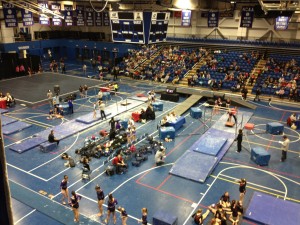 As we prepare for the end of the season I am reminded that Gymnastics is not a test you can cram for. To really be successful in gymnastics you need to prepare well and prepare early. In the final weeks or month of a season you may be able to save a tenth here or there but you are not going to make any HUGE changes to routine. In a recent USECA newsletter, Dr. Sands expresses his enthusiasm for the upcoming Olympic Games and the dramatic routines and skills athletes from the USA are doing. At recent International competitions athletes from the USA have shown a superior level of difficulty and execution. Dr. Sands goes on to warn:
As we prepare for the end of the season I am reminded that Gymnastics is not a test you can cram for. To really be successful in gymnastics you need to prepare well and prepare early. In the final weeks or month of a season you may be able to save a tenth here or there but you are not going to make any HUGE changes to routine. In a recent USECA newsletter, Dr. Sands expresses his enthusiasm for the upcoming Olympic Games and the dramatic routines and skills athletes from the USA are doing. At recent International competitions athletes from the USA have shown a superior level of difficulty and execution. Dr. Sands goes on to warn:
Sadly, If history repeats itself (and it tends to), we will likely lose 2 to 3 of our best athletes due to injury on the way to the Olympic Games. Coaches and athletes – think twice and then twice again when performing while fatigued. Get prepared early. Past data showed that coaches tended to wait too long to prepare and thus increased the fatigue and instability of performances by doing so. Don’t get caught; establish your routines early so that you can concentrate on perfection and specific fitness as you approach the Trials and Games.
All too often I have heard coaches talk about the skills they are going to add to routines for States, Regionals or Nationals. The real conversation should be about what skills they are going to TAKE OUT.
It may be too late for this year but you can lay the base for next year NOW. I am certainly NO expert, I have made thousands of mistakes (and I like to believe that I have learned from MOST of them). With that being said, here are my thoughts on a training plan for the year. Keep in mind that every situation is different. Every athlete is different. BUT, before you come up with more individual training plans you must have a general one.
September 1st. 110% of all skills needed for this years routines. Although landings can be “soft” the skill itself needs to be performed by the athlete without spot. Why 110%? Injuries and fatigue are reality in gymnastics. It is better to be over prepared and be able to take skills out if their routines then to try to add something. By Having MORE than what they need, they remain competitive at their level even when you take skills out.
End of October. All Routines onto competition surface. This doesn’t have to happen every day but my experience has shown me that if they are not doing it in a routine by this time of the year, they are not going to add it as you are now starting to focus on more and more routines.
End of November. Should have had 1st meet. Lots of difficulty, lots of falls. That is OK. Need to get the experience
Mid December (I use this as a date because I have a meet at my gym. Kids are comfortable, it is a cheap entry fee with no travel). Hardest difficulty of the year.
Beginning of January. We usually have a couple of meets in t first 1/2 of January. Because of Holidays and potential of snow days (yeah- we get those up here) workout can be a little inconsistent. These meets we start taking skills out of Routines and focusing on consistency of routines in practice and competitions.
February. In general, the routines that we are competing in February will be the routines we compete for the remainder of the season.
March Typically State Meet. My goal is to get the kids through the State Meet and to Regionals and Nationals without injury. We Train Hard. Nearly 100% focus on perfecting routines and consistency. I get pretty paranoid and really try NOT TO take any unnecessary risks in the gym. Even a twisted ankle at this point in the season could be disastrous. We try very hard to make every practice like a competition. Timed warm up etc.
April/ May– Level 9/10 Regional Championships and National Championships. Just be consistent in routines. Clean Landings. Good handstands. It may be boring for the kids so try to make things small contests.
After Nationals– 1 week of just easy drills in the gym. No risks. Then start to play with the skills that you took out of routines earlier in the year.
There are so many other factors that go into a “good year”. Nutrition, Conditioning, Time to Recover. This is just the tip of the iceberg. Good luck!
Have some thoughts and want to share your training plan? Keep the MOMENTUM going. SHARE




